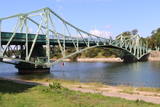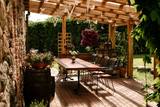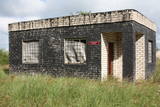| Нo | Название | Описание |
|---|---|---|
|
The bridge was built in 1906. Part of it was blown up during World War I and later restored. During the Soviet occupation, one needed special permits to cross the bridge. Military ships and other vessels used the canal, because one of the largest military bases in the USSR was sited here. In the summer of 2006, one month before the bridge’s centenary, a Georgian-flagged tanker, the Anna, rammed into the northern support structure of the bridge, and that destroyed the bridge’s turning part beyond recognition. The bridge was renovated and reopened in 2009. You can look at the bridge and cross it at any time.This is a unique engineering monument, and it is the only drawbridge of its kind in the Baltic States. It takes just five minutes to turn the two parts of the bridge.
|
||
|
Aktīvās atpūtas parka “Godiņu Piedzīvojumu Platforma” piedāvā organizētus pārgājienus, ejot ar kājām, braucot ar velo, nūjojot, skrienot, vienam, ar draugiem, ar ģimeni, ar kolēģiem, ar četrkājaino draugu. Venlaikus ir iespēja baudīt koka flautas brīnumainās skaņas meža ielokā un pašam izgatavot savu pūšaminstrumentu. |
||
|
Из Рижского аэропорта тур ведет прямо за город, в усадьбу Яунмоку, окруженную красивым парком. А на следующий день начинается наблюдение за птицами в Национальном парке Кемери, включая заболоченные территории и территории вокруг озера Каниерис и деревни Кемери. Затем маршрут следует вдоль западного побережья Рижского Залива, делая на пути небольшие остановки и включая более длительные прогулки в Мерсрагсе. Затем вы проведете некоторое время на мысе Колка и в его окрестностях, которые считаются основным местом миграции. Посетите широколиственные леса Национального парка Слитере вокруг древнего побережья Балтийского Ледового моря и проедьте сквозь пойменные Ужавские луга, затем сделайте остановку в самой западной точке страны, Акменьрагсе. Маршрут продолжается в Лиепае и Орнитологической станции Папе и озере, где есть возможность провести ночь, наблюдая за миграцией сов, если она уже началась. Затем мы проедем через лесную территорию Зварте и остановимся несколько раз на рыбных прудах на пути обратно в Ригу. |
||
|
Летний дом и баня с каминным залом на берегу озера Сила. Баня – каминный зал, баня, душ, 2-местная спальня. Летний дом – одна комната с двумя отдельными кроватями, сухой туалет.
|
||
|
Brīvdienu mājiņas Jūvgumegi atrodas Kurzemes reģiona Mazirbē, Slīteres nacionālajā parkā. Viesiem tiek piedāvātas četrvietīgas un divvietīgas naktsmītnes ar bezmaksas privātu autostāvvietu. Visās ir pieejama virtuve ar ledusskapi un plīts virsmu, kā arī tualete, duša izvietota uz terases. Līdz liedagam 400m. |
||
|
This route section takes you to the Dzūkija National Park – it is among Lithuania’s most forested and desolate nature areas –, and to the town of Druskininkai – a popular SPA and mineral water health resort on the banks of the river Nemunas. When in Druskininkai, we recommend dipping yourself in mineral water baths, enjoying the trip with the cable car over the river Nemunas, visiting the musical fountain, and walking along the river promenade. The starting point of the hiking route is the village of Didžiasalis, which is reached by bus from Druskininkai. From there, the route will take you through vast coniferous forests, rich in berries and mushrooms, and small villages. As you get to Druskininkai, the Forest Trail will meander along the small streets and parks of the historic resort of Druskininkai, crossing the river Ratnyčia and the forest park on the right bank of the Nemunas valley. Leaving the resort town behind, the Forest Trail runs on the side of the village revealing you the beautiful landscapes and the view of the Liškiava monastery on the other bank of the river Nemunas. Up to the village of Žiogeliai, the route goes along forest roads and continues along the banks of the Nemunas valley, surrounded by the vast Dzūkija forests. Towards the end of the route, climb up the Merkinė Mound and it will surprise you with breathtaking views of southern Lithuania. |
||
|
Кафе находится в южной части Вецпиебалги. Интерьер помещения кафе выполнен в дубе, а также использованы письменные знаки латышей и витражи. Время работы: пн. - чт.: 8:00 – 22:00; пт., сб.: 8:00 – 01:00; вс.: 8:00 – 22:00. |
||
|
В усадьбе предлагают ознакомительную экскурсию по БраВору поместья Бутаутай, велосипедные походы, водные развлечения, рыболовство на реке Левуо, а также блюда, обильные хмелем. |
||
|
Saimnieki piedāvā vietu, kur aizbraukt brīvā laika pavadīšanai, atpūtā ģimenei Kurzemē. Šeit viesiem ir iespēja aplūkot sākot no dažādu laiku lauksaimniecības tehnikas un darbarīkiem, līdz pat kara laika paliekām, kā arī dažādu laiku sadzīviskos priekšmetus. Katram priekšmetam seko arī stāsti, kas ir piedzīvoti vai tikai dzirdēti. Tāpat apmeklētājiem ir iespēja apskatīt mājas iemītniekus,kas ir veidoti ar pašu rokām. Asākām un patīkamākām sajūtām pieejama 350 metrus gara Baskāju taka. |
||
|
Радиотехническая рота в Лужня во времена Советского Союза входила в состав береговой погранохраны. Хороший обзор на когда-то военный комплекс открывается с автостоянки в центре Лужня. Отдельные здания используются в качестве жилых зданий.
|
||
|
Находится на обочине дороги Друвиена – Лиэзерс. В историческом здании школы в 1964 г. создан музей. Имя школы связано с латышским писателем Янисом Поруком (1871 - 1911), в часть которого создана памятная комната. На втором этаже можно побывать в классе, посидеть на старинных школьных скамьях и ощутить себя учеником прошлого. Интересные экспонаты – сундуки для хлеба, - такие же, как во времена героев рассказов Порука – Цибиня и Буньга. |
||
|
С исторической и архитектурной точки зрения – интересный памятник градостроительства 17-19 веков. Старый город Лиепаи находится в районе Старой рыночной площади и площади Куршу, где торговля велась с 60-х годов 16 века. До 1792 г. площадь Куршу была также местом исполнения наказаний. В 1910 году рядом с ней был построен теперешний павильон рынка Петра (Петертиргус). При взгляде на карту видно, что сеть улиц вплоть до наших дней сохранила частичную хаотичность средневековых городских центров. |
||
|
Lietuvas lielākais sūnu purvs, kura aizsardzības nolūkā ir izveidots Čepkeļu dabas rezervāts (Čepeklių gmatinis rezervatas). Tas izvietojies starp Dzūkijas nacionālā parka dienvidaustrumu daļu un Baltkrieviju. No Marcinkones pa smilšainu meža ceļu (~ 9 km turp - atpakaļ) ar kājām vai divriteni (arī nelielu tūrisma autobusu līdz 20 vietām) var nokļūt līdz purva malai, kur mežainās kāpās un purvā izveidota 1,5 km gara dabas taka un skatu tornis, no kura labi pārredzama purva rietumdaļa. Pirms došanās uz Čepkeļu purvu, ir jāreģistrējas Dzūkijas nacionālā parka apmeklētāju centrā (Šilagėlių gatve 11), kas meklējams aiz dzelzceļa pārbrauktuves. Te apskatāma neliela nacionālajam parkam un rezervātam veltīta ekspozīcija. |
||
|
This is a comparatively large lake (3 km long and 1.3 km wide). It is shallow (no more than 1.1 m deep) and is classified as a seashore lake. The Vecslocene River flows through it. At the southern end, there is a narrow stream which connects Lake Sloka with Aklo Lake – a shallow and small lake with a dolomite bed at some locations. The best view of Lake Sloka can be seen from the bird watching tower on its north-western shore. This is the only floating bird watching tower in Latvia. Alongside it is the beginning of the 3 km Lake Sloka hiking trail, which passes through the flooded wetlands of the lower reaches of the Vēršupīte. An information stand can be found on the shore of Lake Sloka by the car park. Beyond it is a sulphurous spring. |
||
|
Mini zooloģiskais dārzs Brocēnu novadā, kur iespējams gan apskatīt, gan samīļot dažādus dzīvniekus lauku vidē. Sētā ir arī ugunskura vieta un nojume, kur patverties lietus laikā.
|
||
|
The building was built in 1800 and rebuilt in 1825. Zosna Catholic Church is one of the smallest wooden churches in Latgale and the oldest church of the Rāzna National Park. The building is famous for the altarpiece "Madonna with a child". Noteworthy is also the gate, fence (built from red bricks and boulders) and the bell tower. Not far from the church there lives a manager with whom you can agree on seeing the church from the inside. |
||
|
The restaurant is located half an hour's drive from Madona. Every time dinner "Evening on the Lake" is chosen by other chefs. |
||
|
На востоке от дороги Эзермуйжи - Думеле находится древнее русло (балка) Диевиньэзера. Это было одно из самых больших озер в Курземе - длиной 7,5 км и шириной 1,6 км. В 1838 году был вырыт канал - теперяшняя Мелнсилупе - и озерную воду спустили в море, чтобы получить плодородную почву для сельского хозяйства. Жители Эзермуйжи еще со времен баронов были связаны с лесным хозяйством и лесозаготовками. Думеле с Кошрагсом связывает одинокая лесная дорога - т.н. Нижняя дорога - по которой проходит велосипедный маршрут. В Думеле расположен коттедж для отдыха «Зиедкални». |
||
|
Хозяйка предлагает узнать больше о дикорастущих растениях, об эликсирах из них, рассказывает, как использовать растения для укрепления здоровья. |
||
|
SIA "3x9 zālītes" piedāvā ļoti plašu klāstu zāļu tējas un to maisījumus. Zālītes ievāktas Vecpiebalgas novadā, ekoloģiski tīrās pļavās un mežos. Zālītes vāktas atbilstoši dabas ritmam un mēness fāzēm. Kaltētas dabīgos apstākļos, saglabājot zālīšu vērtīgās vielas, smaržu un garšu. |
||


























